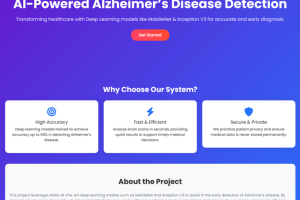
Enhanced Skin Disease Detection and Classification using Deep Learning
Enhanced Skin Disease Detection and Classification using Deep Learning
IEEE BASE PAPER TITLE:
Dynamic Subcluster-Aware Network for Few-Shot Skin Disease Classification
IEEE BASE PAPER ABSTRACT:
This article addresses the problem of few-shot skin disease classification by introducing a novel approach called the sub-cluster-aware network (SCAN) that enhances accuracy in diagnosing rare skin diseases. The key insight motivating the design of SCAN is the observation that skin disease images within a class often exhibit multiple sub-clusters, characterized by distinct variations in appearance.
To improve the performance of few-shot learning (FSL), we focus on learning a high-quality feature encoder that captures the unique sub-clustered representations within each disease class, enabling better characterization of feature distributions. Specifically, SCAN follows a dual-branch framework, where the first branch learns classwise features to distinguish different skin diseases, and the second branch aims to learn features, which can effectively partition each class into several groups so as to preserve the sub-clustered structure within each class.
To achieve the objective of the second branch, we present a cluster loss to learn image similarities via unsupervised clustering. To ensure that the samples in each subcluster are from the same class, we further design a purity loss to refine the unsupervised clustering results. We evaluate the proposed approach on two public datasets for few-shot skin disease classification.
The experimental results validate that our framework outperforms the state-of-the-art methods by around 2%–5% in terms of sensitivity, specificity, accuracy, and F1-score on the SD-198 and Derm7pt datasets.
PROJECT OUTPUT VIDEO:
ALGORITHM / MODEL USED:
InceptionV3, MobileNet.
OUR PROPOSED PROJECT ABSTRACT:
Skin diseases affect millions of people globally, making early and accurate diagnosis crucial for effective treatment. This project, titled “Enhanced Skin Disease Detection and Classification using Deep Learning” aims to automate the identification of common skin conditions using advanced convolutional neural network (CNN) architectures. The system is developed using Python as the backend programming language, HTML, CSS, and JavaScript for the front end, and Flask as the web framework to enable an interactive web-based interface.
Two pre-trained deep learning models: InceptionV3 and MobileNet are employed separately to classify nine categories of skin conditions: BA-Cellulitis, BA-Impetigo, FU-Athlete-foot, FU-Nail-Fungus, FU-Ringworm, PA-Cutaneous-Larva-Migrans, VI-Chickenpox, VI-Shingles, and Normal. The dataset comprises a total of 984 images, with the following class-wise distribution: BA-Cellulitis (136), BA-Impetigo (80), FU-Athlete-foot (124), FU-Nail-Fungus (129), FU-Ringworm (90), PA-Cutaneous-Larva-Migrans (100), VI-Chickenpox (136), VI-Shingles (130), and Normal (59).
The InceptionV3 model achieved a training accuracy of 97% and a test accuracy of 93%, while the MobileNet model achieved a perfect training accuracy of 100% and a test accuracy of 97%. Performance evaluation metrics such as Accuracy, Precision, Recall, and F-Measure were computed to assess the models. The MobileNet model outperformed InceptionV3, attaining an accuracy of 97.3%, precision of 96.5%, recall of 97.3%, and an F-measure of 97.3%. In contrast, the InceptionV3 model achieved an accuracy of 93.5%, precision of 92.5%, recall of 93.5%, and an F-measure of 93.5%.
Furthermore, the system includes a comprehensive performance analysis module that displays both numerical results and graphical visualizations. Two key charts: Dataset Class Distribution Chart and Model Accuracy Chart are used for static visualization, providing intuitive insights into data imbalance and model performance.
This enhanced deep learning-based system not only enables accurate and fast classification of skin diseases but also demonstrates the comparative efficacy of different CNN architectures in a medical image classification context.
SYSTEM REQUIREMENTS:
HARDWARE REQUIREMENTS:
- System : Pentium i3 Processor.
- Hard Disk : 20 GB.
- Monitor : 15’’ LED.
- Input Devices : Keyboard, Mouse.
- Ram : 8 GB.
SOFTWARE REQUIREMENTS:
- Operating System : Windows 10 / 11.
- Coding Language : Python 3.12.0.
- Web Framework : Flask.
- Frontend : HTML, CSS, JavaScript.
REFERENCE:
Shuhan Li; Xiaomeng Li; Xiaowei Xu; Kwang-Ting Cheng, “Dynamic Subcluster-Aware Network for Few-Shot Skin Disease Classification”, IEEE TRANSACTIONS ON NEURAL NETWORKS AND LEARNING SYSTEMS, VOL. 36, NO. 1, JANUARY 2025.
👉CLICK HERE TO BUY THIS PROJECT “Enhanced Skin Disease Detection and Classification using Deep Learning” SOURCE CODE👈
Frequently Answered Questions (FAQ’s) & Answers:
1. What is the main objective of this project?
The primary goal of this project is to develop a deep learning-based web application that can detect and classify various common skin diseases from uploaded images. It also provides basic treatment recommendations based on the predicted disease.
2. Which skin diseases can the system detect?
The system can classify images into the following nine categories: • BA-Cellulitis • BA-Impetigo • FU-Athlete-foot • FU-Nail-Fungus • FU-Ringworm • PA-Cutaneous-Larva-Migrans • VI-Chickenpox • VI-Shingles • Normal (no disease)
3. Which machine learning models are used in the system?
The system uses two pre-trained deep learning models: • InceptionV3 (Training Accuracy: 97%, Test Accuracy: 93%) • MobileNet (Training Accuracy: 100%, Test Accuracy: 97%) Users can choose either model for disease prediction.
4. How does the system process an image for prediction?
Users upload a skin image through the web interface. The image is resized, normalized, and passed through the selected deep learning model (InceptionV3 or MobileNet). The model then predicts the most likely skin disease class.
5. What type of images should be uploaded for accurate results?
The image should be: • Clear and focused • Taken in good lighting • Free of background noise • In .jpg format This helps ensure accurate prediction by the model.
6. Does the system provide treatment suggestions?
Yes. After a disease is detected, the system displays a set of basic treatment recommendations including over-the-counter medicines, general care tips, and advice on when to consult a doctor.
7. Can users download the diagnosis result?
Yes. The system offers a Download PDF Report feature, which allows users to download a report that includes the predicted disease, treatment recommendations, model used, and image reference.
8. Are the predictions 100% accurate?
While the system is trained with high accuracy models (up to 97% test accuracy), it is not a substitute for professional medical advice. Predictions are based on pattern recognition and should be used as a preliminary diagnostic tool, not as a final diagnosis.
9. What is the size and structure of the dataset used?
The dataset consists of 984 images distributed across nine classes: • BA-Cellulitis: 136 images • BA-Impetigo: 80 images • FU-Athlete-foot: 124 images • FU-Nail-Fungus: 129 images • FU-Ringworm: 90 images • PA-Cutaneous-Larva-Migrans: 100 images • VI-Chickenpox: 136 images • VI-Shingles: 130 images • Normal: 59 images
10. How are the models evaluated?
Model performance is evaluated using standard classification metrics: • Accuracy • Precision • Recall • F-Measure • Confusion Matrix. Additionally, visual performance analysis is presented using charts for dataset distribution and model comparison.



